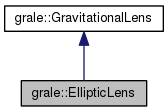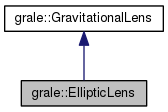Base class for the lens effect by an elliptical lens, based on the information of the circular equivalent. More...
#include <ellipticlens.h>
Inheritance diagram for grale::EllipticLens:

Collaboration diagram for grale::EllipticLens:

Additional Inherited Members | |
 Public Types inherited from grale::GravitationalLens Public Types inherited from grale::GravitationalLens | |
| enum | LensType { Gaussian, MultiplePlummers, Plummer, Pointmass, SIS, NSIE, NSIS, SIE, Square, MultipleSquares, MultipleGaussians, MassSheet, Composite, MassDisk, Profile, PolynomialMassProfile, MultipleWendland, DeflectionGrid, NFW, EllipticNFW, Sersic, EllipticSersic } |
| Specific lens types. More... | |
 Public Member Functions inherited from grale::GravitationalLens Public Member Functions inherited from grale::GravitationalLens | |
| LensType | getLensType () const |
| Returns the type of the lens. | |
| virtual bool | init (double D_d, const GravitationalLensParams *pLensParams=0) |
Initializes the lens with parameters params, setting its angular diameter distance to D_d. | |
| bool | traceTheta (double D_s, double D_ds, Vector2D< double > theta, Vector2D< double > *pBeta) const |
| Calculates the result of the lens equation. | |
| virtual double | getInverseMagnification (double D_s, double D_ds, Vector2D< double > theta) const |
| Returns the inverse magnification factor for a specific direction. | |
| double | getLensDistance () const |
| Returns the D_d parameter used in the GravitationalLens::init function. | |
| void | setLensDistance (double D_d) |
| Changes the lens distance. | |
| const GravitationalLensParams * | getLensParameters () const |
| Returns a pointer to a copy of the lens parameters used in the GravitationalLens::init function. | |
| virtual void | setDerivativeAngularDistanceScale (double distanceScale) |
| Sets a distance scale to be used when estimating the derivatives of the function beta(theta) numerically. | |
| bool | write (serut::SerializationInterface &si) const |
| Writes the current lens to a serut::SerializationInterface instance. | |
| bool | save (const std::string &fileName) const |
| Writes the current lens to a file. | |
| GravitationalLens * | createCopy () const |
| Creates a copy of the current lens instance. | |
 Static Public Member Functions inherited from grale::GravitationalLens Static Public Member Functions inherited from grale::GravitationalLens | |
| static double | getInverseMagnification (double D_s, double D_ds, double axx, double ayy, double axy) |
| Calculate inverse magnification from derivatives of deflection angle. | |
| static void | getShearInfo (double D_s, double D_ds, double axx, double ayy, double axy, double *pShearAngle, double *pShearSize) |
| Calculate shear size and angle from derivatives of the deflection angle. | |
| static void | getShearInfo (double gamma1, double gamma2, double *pShearAngle, double *pShearSize) |
| Calculate shear size and angle from shear components. | |
| static bool | read (serut::SerializationInterface &si, GravitationalLens **pLens, std::string &errorString) |
Reads a lens instance from a serut::SerializationInterface object and stores the lens in lens; an error message is stored in errstr if the function is not successful. | |
| static bool | load (const std::string &fileName, GravitationalLens **pLens, std::string &errorString) |
Loads a lens instance from a file and stores the lens in lens. | |
 Protected Member Functions inherited from grale::GravitationalLens Protected Member Functions inherited from grale::GravitationalLens | |
| GravitationalLens (LensType t) | |
| Meant to be used by a specific lens implementation. | |
| virtual bool | processParameters (const GravitationalLensParams *params)=0 |
| Specific lens implementations implement this function to process the parameters specified in the GravitationalLens::init function. | |
Detailed Description
Base class for the lens effect by an elliptical lens, based on the information of the circular equivalent.
Suppose we have a circularly symmetric lens, in which the integrated (projected) mass is described by:
![\[ \textrm{M}_c(\theta) = 2\pi D_d^2 \int_0^\theta \Sigma_c(\theta') \theta' d\theta' \]](form_2.png)
The lens effect by the mass distribution
![\[ \Sigma\left(\vec{\theta}\right) = \Sigma_c\left(\sqrt{\theta_x^2+\frac{\theta_y^2}{q^2}}\right) \]](form_3.png)
can then be described as follows.
First, define the following quantities:
![\[ \xi(u,x,y) = \sqrt{u\left(x^2+\frac{y^2}{1-(1-q^2)u}\right)} \]](form_4.png)
![\[ \textrm{H}(\theta) = \frac{1}{\theta}\frac{d\Sigma_c}{d\theta}(\theta) \]](form_5.png)
![\[ \textrm{I}(x,y) = \frac{4 G}{c^2 D_d}\int_0^1 \frac{\textrm{M}_c\left(\xi(u,x,y)\right)}{u} \frac{1}{\sqrt{1-(1-q^2)u}} du \]](form_6.png)
![\[ \textrm{J}_n(x,y) = \frac{4 \pi G D_d}{c^2} \int_0^1 \frac{\Sigma_c\left(\xi(u,x,y)\right)}{\left(1-(1-q^2)u\right)^{\left(n+\frac{1}{2}\right)}} du \]](form_7.png)
![\[ \textrm{K}_n(x,y) = \frac{4 \pi G D_d}{c^2} \int_0^1 \textrm{H}\left(\xi(u,x,y)\right) \frac{u}{\left(1-(1-q^2)u\right)^{\left(n+\frac{1}{2}\right)}} du \]](form_8.png)
One then has the following expressions for the lensing potential, deflection angle and its derivatives:
![\[ \psi\left(\vec{\theta}\right) = \frac{D_{ds}}{D_s} \frac{q}{2} \textrm{I}(\theta_x, \theta_y) \]](form_9.png)
![\[ \hat{\alpha}_x\left(\vec{\theta}\right) = q \theta_x \textrm{J}_0(\theta_x, \theta_y) \]](form_10.png)
![\[ \hat{\alpha}_y\left(\vec{\theta}\right) = q \theta_y \textrm{J}_1(\theta_x, \theta_y) \]](form_11.png)
![\[ \frac{\partial \hat{\alpha}_x}{\partial\theta_x}\left(\vec{\theta}\right) = q \textrm{J}_0(\theta_x, \theta_y) + q \theta_x^2 \textrm{K}_0(\theta_x, \theta_y) \]](form_12.png)
![\[ \frac{\partial \hat{\alpha}_y}{\partial\theta_y}\left(\vec{\theta}\right) = q \textrm{J}_1(\theta_x, \theta_y) + q \theta_y^2 \textrm{K}_2(\theta_x, \theta_y) \]](form_13.png)
![\[ \frac{\partial \hat{\alpha}_x}{\partial\theta_y}\left(\vec{\theta}\right) = q \theta_x\theta_y \textrm{K}_1(\theta_x, \theta_y) \]](form_14.png)
References
The documentation for this class was generated from the following file:
- src/lens/ellipticlens.h
 1.8.1.1
1.8.1.1